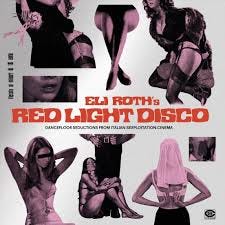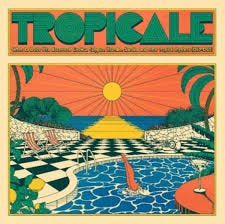Can’t lie: It was the cover collage – of women in lingere, shown in provocative scenes from Italian films – that initially got me curious about Eli Roth’s Red Light Disco.
The compilation, discussed last week in this space, spotlights the music featured in Italian “sexploitation” films of the 1960s. Curating with an emphasis on groove over deep melody, Roth drew upon the vast audio archives of the CAM Sugar label, which preserves and celebrates the rich history of Italian film music.
The imprint’s catalog offers multiple volumes of rarities by film composer Ennio Morricone (like the Morricone Segreto Songbook, below, which collects the prolific legend’s overlooked songs), as well as reissues of full soundtracks (there’s a new vinyl edition of Nino Rota’s revered Fellini’s Amarcord in the shop) and assorted thematic compilations.
Here we should pause for a moment of gratitude. Sure, the world we knew just 6 months ago is now under existential threat, but look! A small label with a righteous mission and a laser focus is thriving in 2025! And thanks to the wonders of technology, we are able to explore, at a casual graze or deep-dive depth, this label’s holdings instantly, from a smartphone. Then there’s the fact that this is a rarified and specialized lane of inquiry – not mainstream pop but Italian film music, of all things, mostly from the 1960s. And, as is often the case, beneath that broad classification are worlds containing curious sub-worlds to explore: What begins as idle curiousity about a cover image can become an extended foray into sublime and magical sounds of a sort that were likely unimaginable an hour before. Mindblowing.
After Red Light Disco, my first stop was the Morricone track above, which comes from one of several anthologies devoted to lesser-known songs. Then I discovered that CAM Sugar maintains a “Journal” on its site, and began reading about another towering figure of film music, Piero Umiliani – specificially, the beginning of his infatuation with synthesis. The piece tells of Umiliani’s purchase of the VCS 3 analog synth, manufactured by EMS and used by Pink Floyd (parts of “Shine On You Crazy Diamond”) and others. Umiliani’s first recordings on the instrument were in 1972, on an album called Switched On Naples. Here’s an unsatisfying vinyl transfer posted to YouTube:
Umiliani did smart, enduring work for film, and in his spare time at his Rome studio Sound Work Shop, recorded electronic pieces across an astonishing range – some slight and campy pieces (“Synthi Bossa Nova”) that sound destined to be forgotten in an anonymous cue library, others from the same album that are disarmingly beautiful (“Synthi Marcia”) — check those wah-wah-like pitch bends!
From there it was an easy stroll into another CAM Sugar anthology, Synth Utopia, which was released as a digital-only offering in January. Curated by the electronic musician Machinedrum, it features works from film and library music catalogs and spotlights some inventive sound manipulations, including the filtering drones of “Magnetic Fluid,” from composer Carlo Maria Cordio’s score to Rosso Sangue – Absurd.
Also here is a fantastical, almost cartoonish work by the spaghetti western composer Marcello Giombini. The bright, blithe “Synthotango” borrows Umiliani’s naming convention while observing the stop-time pauses and rituals of tango.
As Red Light Disco makes plain, CAM Sugar brings a welcome irreverence to archive work. The curators understand the playful nature of film as well as the culture of Italy’s film industry, and through compilations like BOOM: Italian Jazz Soundtracks at Their Finest (1959-1969), manage to celebrate those aspects. Here’s a Umiliani big-band track studded with echoes of Dizzy Gillespie’s “A Night In Tunesia.”
Also on this set is Umiliani’s “Tensione,” which is enlivened by a crisp, unexpectedly articulate Chet Baker solo:
These pieces are often short sketches, the musical equivalent of line drawings. They exhibit awareness of, and deep appreciation for, genre cues and stereotypes. Several BOOM highlights start in a generic noctural “jazz” vibe, but quickly evolve into more – moody, somewhat unpredictable evocations like Carlo Rusticelli’s “Sexy Lucy,” which lasts just over a minute.
Compilations like BOOM and Tropicale: When La Dolce Vita Discovered exotica, calypso, mambo, samba and other tropical rhythms (1959–1969) illustrate how Italian film composers seized (and exploited!) the musical trends that were bouncing around global pop culture in the ‘60s. They fell hard for the pulse of calypso yet struggled to emulate the bouyant melodies, they embraced the sway of samba without catching its harmonic richness. Still, sometimes the trappings are enough to suggest exotic movie locales: Umiliani’s chipper 1966 “Che Notte Ragazzi (Bossa Vocalizzata)” celebrates the sunny optimism and crisply rhythmic ensemble vocals common in Brazilian music at that time.
Tropicale is the most pastiche-like, least musically dimensional of the themed CAM Sugar sets I heard. But even these light, whimsical pieces are saturated with invention; they reshuffle tropes in imaginative ways. You may never take notice the cha cha cha pulse as it slithers into the scene of La Commare Secca, and that’s part of the subtle magic these composers brought to Italian film. Should you wish to explore these unexpected confluences of sound and image in more depth, the archives of CAM Sugar await.






